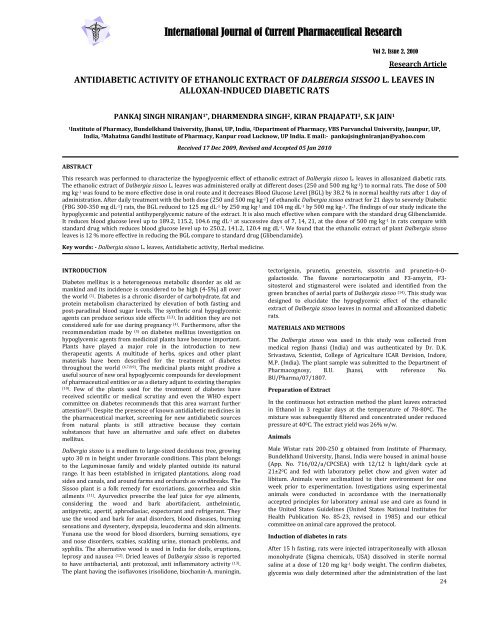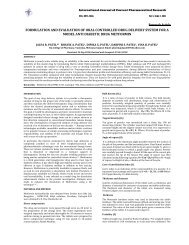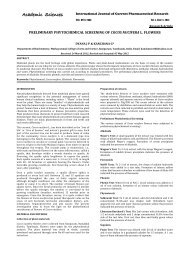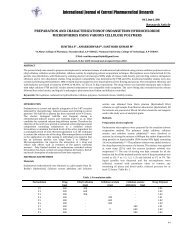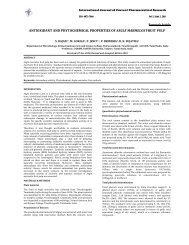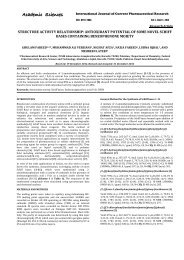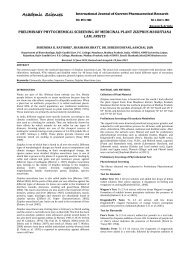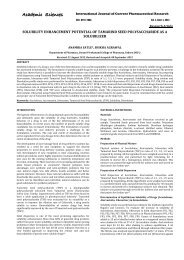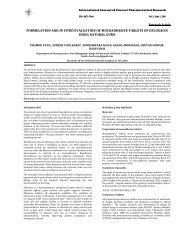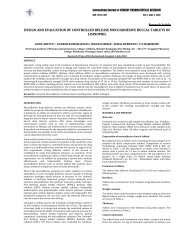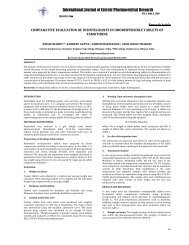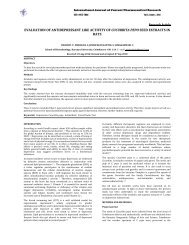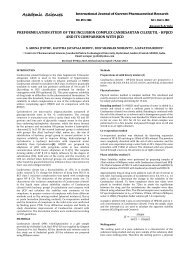antidiabetic activity of ethanolic extract of dalbergia sissoo l. leaves ...
antidiabetic activity of ethanolic extract of dalbergia sissoo l. leaves ...
antidiabetic activity of ethanolic extract of dalbergia sissoo l. leaves ...
- No tags were found...
You also want an ePaper? Increase the reach of your titles
YUMPU automatically turns print PDFs into web optimized ePapers that Google loves.
International Journal <strong>of</strong> Current Pharmaceutical ResearchVol 2, Issue 2, 2010Research ArticleANTIDIABETIC ACTIVITY OF ETHANOLIC EXTRACT OF DALBERGIA SISSOO L. LEAVES INALLOXANINDUCED DIABETIC RATSPANKAJ SINGH NIRANJAN 1* , DHARMENDRA SINGH 2 , KIRAN PRAJAPATI 3 , S.K JAIN 11Institute <strong>of</strong> Pharmacy, Bundelkhand University, Jhansi, UP, India, 2 Department <strong>of</strong> Pharmacy, VBS Purvanchal University, Jaunpur, UP,India, 3 Mahatma Gandhi Institute <strong>of</strong> Pharmacy, Kanpur road Lucknow, UP India. E mail: pankajsinghniranjan@yahoo.comReceived 17 Dec 2009, Revised and Accepted 05 Jan 2010ABSTRACTThis research was performed to characterize the hypoglycemic effect <strong>of</strong> <strong>ethanolic</strong> <strong>extract</strong> <strong>of</strong> Dalbergia <strong>sissoo</strong> L. <strong>leaves</strong> in alloxanized diabetic rats.The <strong>ethanolic</strong> <strong>extract</strong> <strong>of</strong> Dalbergia <strong>sissoo</strong> L. <strong>leaves</strong> was administered orally at different doses (250 and 500 mg kg ‐1 ) to normal rats. The dose <strong>of</strong> 500mg kg ‐1 was found to be more effective dose in oral route and it decreases Blood Glucose Level (BGL) by 38.2 % in normal healthy rats after 1 day <strong>of</strong>administration. After daily treatment with the both dose (250 and 500 mg kg ‐1 ) <strong>of</strong> <strong>ethanolic</strong> Dalbergia <strong>sissoo</strong> <strong>extract</strong> for 21 days to severely Diabetic(FBG 300‐350 mg dL ‐1 ) rats, the BGL reduced to 125 mg dL ‐1 by 250 mg kg ‐1 and 104 mg dL ‐1 by 500 mg kg‐ 1 . The findings <strong>of</strong> our study indicate thehypoglycemic and potential antihyperglycemic nature <strong>of</strong> the <strong>extract</strong>. It is also much effective when compare with the standard drug Glibenclamide.It reduces blood glucose level up to 189.2, 115.2, 104.6 mg dL ‐1 at successive days <strong>of</strong> 7, 14, 21, at the dose <strong>of</strong> 500 mg kg ‐1 in rats compare withstandard drug which reduces blood glucose level up to 250.2, 141.2, 120.4 mg dL ‐1 . We found that the <strong>ethanolic</strong> <strong>extract</strong> <strong>of</strong> plant Dalbergia <strong>sissoo</strong><strong>leaves</strong> is 12 % more effective in reducing the BGL compare to standard drug (Glibenclamide).Key words: Dalbergia <strong>sissoo</strong> L. <strong>leaves</strong>, Antidiabetic <strong>activity</strong>, Herbal medicine.INTRODUCTIONDiabetes mellitus is a heterogeneous metabolic disorder as old asmankind and its incidence is considered to be high (4‐5%) all overthe world (1) . Diabetes is a chronic disorder <strong>of</strong> carbohydrate, fat andprotein metabolism characterized by elevation <strong>of</strong> both fasting andpost‐paradinal blood sugar levels. The synthetic oral hypoglycemicagents can produce serious side effects (2,3) . In addition they are notconsidered safe for use during pregnancy (4) . Furthermore, after therecommendation made by (5) on diabetes mellitus investigation onhypoglycemic agents from medicinal plants have become important.Plants have played a major role in the introduction to newtherapeutic agents. A multitude <strong>of</strong> herbs, spices and other plantmaterials have been described for the treatment <strong>of</strong> diabetesthroughout the world (6,7,8,9) . The medicinal plants might prodive auseful source <strong>of</strong> new oral hypoglycemic compounds for development<strong>of</strong> pharmaceutical entities or as a dietary adjunt to existing therapies(10). Few <strong>of</strong> the plants used for the treatment <strong>of</strong> diabetes havereceived scientific or medical scrutiny and even the WHO expertcommittee on diabetes recommends that this area warrant furtherattention (5) . Despite the presence <strong>of</strong> known <strong>antidiabetic</strong> medicines inthe pharmaceutical market, screening for new <strong>antidiabetic</strong> sourcesfrom natural plants is still attractive because they containsubstances that have an alternative and safe effect on diabetesmellitus.Dalbergia <strong>sissoo</strong> is a medium to large‐sized deciduous tree, growingupto 30 m in height under favoranle conditions. This plant belongsto the Leguminosae family and widely planted outside its naturalrange. It has been established in irrigated plantations, along roadsides and canals, and around farms and orchards as windbreaks. TheSissoo plant is a folk remedy for excoriations, gonorrhea and skinailments (11) . Ayurvedics prescribe the leaf juice for eye ailments,considering the wood and bark abortifacient, anthelmintic,antipyretic, apertif, aphrodiasiac, expectorant and refrigerant. Theyuse the wood and bark for anal disorders, blood diseases, burningsensations and dysentery, dyspepsia, leucoderma and skin ailments.Yunana use the wood for blood disorders, burning sensations, eyeand nose disorders, scabies, scalding urine, stomach problems, andsyphilis. The alternative wood is used in India for doils, eruptions,leprosy and nausea (12) . Dried <strong>leaves</strong> <strong>of</strong> Dalbergia <strong>sissoo</strong> is reportedto have antibacterial, anti protozoal, anti inflammatory <strong>activity</strong> (13) .The plant having the is<strong>of</strong>lavones irisolidone, biochanin‐A, muningin,tectorigenin, prunetin, genestein, sissotrin and prunetin‐4‐Ogalactoside.The flavone norartocarpotin and F3‐amyrin, F3‐sitosterol and stigmasterol were isolated and identified from thegreen branches <strong>of</strong> aerial parts <strong>of</strong> Dalbergia <strong>sissoo</strong> (14) . This study wasdesigned to elucidate the hypoglycemic effect <strong>of</strong> the <strong>ethanolic</strong><strong>extract</strong> <strong>of</strong> Dalbergia <strong>sissoo</strong> <strong>leaves</strong> in normal and alloxanized diabeticrats.MATERIALS AND METHODSThe Dalbergia <strong>sissoo</strong> was used in this study was collected frommedical region Jhansi (India) and was authenticated by Dr. D.K.Srivastava, Scientist, College <strong>of</strong> Agriculture ICAR Devision, Indore,M.P. (India). The plant sample was submitted to the Department <strong>of</strong>Pharmacognosy, B.U. Jhansi, with reference No.BU/Pharma/07/1807.Preparation <strong>of</strong> ExtractIn the continuous hot <strong>extract</strong>ion method the plant <strong>leaves</strong> <strong>extract</strong>edin Ethanol in 3 regular days at the temperature <strong>of</strong> 78‐80 0 C. Themixture was subsequently filtered and concentrated under reducedpressure at 40 0 C. The <strong>extract</strong> yield was 26% w/w.AnimalsMale Wistar rats 200‐250 g obtained from Institute <strong>of</strong> Pharmacy,Bundelkhand University, Jhansi, India were housed in animal house(App. No. 716/02/a/CPCSEA) with 12/12 h light/dark cycle at21±2 0 C and fed with laboratory pellet chow and given water adlibitum. Animals were acclimatized to their environment for oneweek prior to experimentation. Investigations using experimentalanimals were conducted in accordance with the inernationallyaccepted principles for laboratory animal use and care as found inthe United States Guidelines (United States National Institutes forHealth Publication No. 85‐23, revised in 1985) and our ethicalcommittee on animal care approved the protocol.Induction <strong>of</strong> diabetes in ratsAfter 15 h fasting, rats were injected intraperitoneally with alloxanmonohydrate (Sigma chemicals, USA) dissolved in sterile normalsaline at a dose <strong>of</strong> 120 mg kg ‐1 body weight. The confirm diabetes,glycemia was daily determined after the administration <strong>of</strong> the last24
alloxan dose. Depending on their Fasting Blood Glucose (FBG) levelthe animals were divided arbitrarily in to 2 groups (9) : Mild Diabetic(MD) animals with FBG <strong>of</strong> 120‐250 mg dL ‐1 , Severely Diabetic (SD)animals showing FBG <strong>of</strong> 250‐300 mg dL ‐1 .EstimationBlodd glucose was estimated by using one touch glucometer (Accucheksensor) <strong>of</strong> Roche Diagnostic, Germany for regular checkup.Blood sample were collected from tail veins.Biological assaysOral glucose tolerance test (OGTT)Animals were fasted 18 hrs. before the day <strong>of</strong> experiment with freeaccess to water and were separated in 5 groups <strong>of</strong> 10 rats each.Animals <strong>of</strong> all groups were treated with an oral D‐glucose load <strong>of</strong> 2gm kg ‐1 by means <strong>of</strong> cannula, Group third and fourth were treatedorally with <strong>ethanolic</strong> <strong>extract</strong> at a dose <strong>of</strong> 250 mg kg ‐1 b.w. and 500mg kg ‐1 b.w. each for 30 min before the oral administration <strong>of</strong> oralglucose load. Control animals were treated with vehicle, bloodsample were withdrawn from the cordal (tail) vein <strong>of</strong> each animalsjust after oral glucose administration (0 min), 30 min, 90 min and120 min after glucose challenge and the fifth group receivedglibenclamide (200 mg kg ‐1 ) as positive control.Statistical analysisAll biochemical results were expressed as mean ± SEM. Significantdifferences among the groups were dtermined by one‐way Analysis<strong>of</strong> Variance (ANOVA) followed by Dunnett‐t test. Statisticalsignificance was considered at P < 0.05.RESULTThe plant <strong>extract</strong> <strong>of</strong> Dalbergia <strong>sissoo</strong> <strong>leaves</strong> (<strong>ethanolic</strong> <strong>extract</strong>)showed <strong>antidiabetic</strong> <strong>activity</strong> by reducing blood glucose levelsignificantly. It is also much effective when compare with thestandard drug Glibenclamide. It reduces blood glucose level up to189.2, 115.2, 104.6 mg dL ‐1 at successive days <strong>of</strong> 7, 14, 21, at thedose <strong>of</strong> 500 mg kg ‐1 in rats compare with the standard drug whichreduces blood glucose level upto 250.2, 141.2, 120.4 mg dL ‐1 . Wefound that the <strong>ethanolic</strong> <strong>extract</strong> <strong>of</strong> plant Dalbergia <strong>sissoo</strong> <strong>leaves</strong> is12% more effective in reducing the blood glucose level compare tothe standard drug (Glibenclamide).LD50The <strong>extract</strong> <strong>of</strong> the test substance (Dalbergia <strong>sissoo</strong> <strong>leaves</strong>) was foundto be safe for further biological studies as no toxic effect andlethality was observed up to 3000 mg kg ‐1 per oral in rat. Only theconsumption <strong>of</strong> food was increased by 20% in the dose <strong>of</strong> 2000 and3000 mg kg ‐1 during 4 h but remaining normal afterwards.Table 1: Shows effect <strong>of</strong> <strong>dalbergia</strong> <strong>sissoo</strong> <strong>leaves</strong> (<strong>ethanolic</strong> <strong>extract</strong>s) on body weight.TreatmentBody weight in gm1 st Day 7 th Day 14 th Day 21 st DayNormal Rats 171±5.50 179±7.33 186±6.25 192±7.58Control Diabetic Rats 155±11.66 153±13.04 146±10.37 142±7.53Diabetic Rats + DS 1 167±5.70* 162±5.70* 175±6.12* 180±6.33*Diabetic Rats + DS 2 138±10.30* 130±7.30* 145±12.20* 158±9.00*Diabetic Rats + SD (Glibenclamide) 130±12.20* 140±13.30* 148±18.90* 166±16.60*Values are Mean±SEM, (n=10), * P
Fig. 2: It shows effect <strong>of</strong> <strong>dalbergia</strong> <strong>sissoo</strong> <strong>leaves</strong> (<strong>ethanolic</strong> <strong>extract</strong>) on blood glucose level (mg dl 1 )DISCUSSIONThe results showed important reductions <strong>of</strong> blood glucose levels inhealthy rats when administered the <strong>ethanolic</strong> <strong>extract</strong> <strong>of</strong> Dalbergia<strong>sissoo</strong> L. <strong>leaves</strong> by oral route.Ethanolic <strong>sissoo</strong> <strong>extract</strong> showed a dose‐dependent effect on FBG upto a dose <strong>of</strong> 500 mg kg ‐1 . The BGL decreases by 38.2 % in normalhealthy rats after 1 day <strong>of</strong> administration. After daily treatment withthe both dose (250 and 500 mg kg ‐1 ) <strong>of</strong> <strong>ethanolic</strong> Dalbergia <strong>sissoo</strong><strong>extract</strong> for 21 days to severely Diabetic (FBG 300‐350 mg dL ‐1 ) rats,the BGL reduced to 125 mg dL ‐1 by 250 mg kg ‐1 and 104 mg dL ‐1 by500 mg kg‐ 1 . The findings <strong>of</strong> our study indicate the hypoglycemicand potential antihyperglycemic nature <strong>of</strong> the <strong>extract</strong>. It is also mucheffective when compare with the standard drug Glibenclamide. Itreduces blood glucose level up to 189.2, 115.2, 104.6 mg dL ‐1 atsuccessive days <strong>of</strong> 7, 14, 21, at the dose <strong>of</strong> 500 mg kg ‐1 in ratscompare with standard drug which reduces blood glucose level upto 250.2, 141.2, 120.4 mg dL ‐1 . We found that the <strong>ethanolic</strong> <strong>extract</strong> <strong>of</strong>plant Dalbergia <strong>sissoo</strong> <strong>leaves</strong> is 12 % more effective in reducing theBGL compare to standard drug (Glibenclamide).The present investigation shows that in MD and SD alloxan‐diabeticrats, <strong>ethanolic</strong> <strong>extract</strong> <strong>of</strong> D. Sissoo caused significant reductions <strong>of</strong>blood glucose levels after 2 h <strong>of</strong> <strong>extract</strong> administration.Glibenclamide (200 mg kg ‐1 ) caused a lesser hypoglycemic effectthan D. Sissoo <strong>ethanolic</strong> <strong>extract</strong> in diabetic rats after 4 h <strong>of</strong> drugadministration. In addition, <strong>ethanolic</strong> <strong>extract</strong> <strong>of</strong> Dalbergia <strong>sissoo</strong> L.<strong>leaves</strong> caused significant hypoglycemic effect in MD and SD rats after14 days treatment, while Glibenclamide exhibited a mildhypoglycemic <strong>activity</strong> in these animals.The mechanism <strong>of</strong> alloxan diabetes has been the subject <strong>of</strong> manyinvestigations and it is now generally accepted that free radicals areselectively involved in the initiation <strong>of</strong> the damage that ultimatelyleads to β‐cell death (15,16) . Therefore, the pancreas is especiallysusceptible to the action <strong>of</strong> alloxan‐induced free‐radical damage.Many substances have been shown to ameliorate the diabetogenicity<strong>of</strong> alloxan in animals, which protect by reacting with free radicalsformed from alloxan during its interaction with the β‐cell, or preventradical formation (17) . Recently, it was reported that the <strong>sissoo</strong><strong>extract</strong>, exhibited significant radical scavenging <strong>activity</strong> and thusantioxidant <strong>activity</strong> (18) and the present finding indicates thatadministration <strong>of</strong> Dalbergia <strong>sissoo</strong> L. <strong>leaves</strong> confirms the possibilitythat the major function <strong>of</strong> the <strong>extract</strong> is on the protection <strong>of</strong> vitaltissues including the pancreas, thereby reducing the causation <strong>of</strong>diabetes in these animals.Therefore, protective effect <strong>of</strong> <strong>sissoo</strong> <strong>extract</strong> on pancreas <strong>of</strong> alloxaninduceddiabetic rats could be attributed directly to scavenging<strong>activity</strong> and for more extent to the regenerative properties <strong>of</strong> the<strong>extract</strong>. In conclusion, our study indicates that <strong>sissoo</strong> <strong>ethanolic</strong><strong>extract</strong> produced antihyperglycemic effects in experimental diabetesby providing a regenerative modification against damage caused byalloxan to endocrine cells <strong>of</strong> the pancreas.However, <strong>ethanolic</strong> <strong>extract</strong> <strong>of</strong> <strong>sissoo</strong> may exert its hypoglycemicaction by mechanisms such as stimulation <strong>of</strong> glucose uptake byperipheral tissues, inhibition <strong>of</strong> insulinase <strong>activity</strong> in both liver andkidney (19), inhibition <strong>of</strong> endogenous glucose production orinhibition <strong>of</strong> renal glucose reabsorption.CONCLUSIONTaken in all, the use <strong>of</strong> this plant in diabetes is then supported butthe precise active substance(s), site(s) and cellular and molecularmechanism(s) <strong>of</strong> this pharmacological effect are still to bedetermined. In addition, the possible long‐term toxic effects <strong>of</strong><strong>ethanolic</strong> <strong>sissoo</strong> <strong>extract</strong> and its mechanism <strong>of</strong> protective effects onthe pancreas also remain to be clarified.REFERENCES1. Pickup J.C. and William G., Epidemiology <strong>of</strong> Diabetes Mellitus.Textbook <strong>of</strong> Diabetes. 2 nd Edn. Blackwell, Oxford, 1, 1997; 3.1‐3.28.2. Akhtar M.S., and iqbal J., Evaluation <strong>of</strong> the hypoglycemic effect<strong>of</strong> Achyranthes aspera in normal and alloxan diabetic rabbits, J.Ethnopharmacol. 31(1)3. Holman R.R. and Turner R.C., Oral Agents and Insulin in theTreatment <strong>of</strong> NIDDM. In: Pickup J. and G. Wiliams (Eds.),Textbook <strong>of</strong> Diabetes, Blackwell, Oxford, 1991; 407‐469.4. Larner J., Insulin and Oral Hypoglycemic Drugs; Glucagon. In:Gilman A.G., Goodman L.S., Rall T.W. andMurad F., (Eds.), ThePharmacological Bases for Therapeutic. 7 th Edn., Macmillan,New York, 1985; 149‐151.5. WHO, Expert committee on Diabetes mellitus, Technicalreports series World Health Organisation, Geneva, 1980.6. Ivorra M.D., Paya M. and Villar A., A review <strong>of</strong> natural productsand plants as potential <strong>antidiabetic</strong> drugs, J.Ethnopharmacology, 27(3), 1989; 243‐275.7. Marles R.J. and Farnsworth N.R., Antidiabetic plants and theiractive constituents, Phytomedicine, 2(2), 1995; 137‐189.8. Kesari A.N., Gupta R.K. and Watal G., Hypoglycemic effect <strong>of</strong>Murraya koenigii on normal and alloxan diabetic rabbits, J.Ethnopharmacol, 97(2), 2005; 247‐251.26
9. Gupta R.K., Kesari A.N., Murthy P.S., Chandra R., Tandon V. andWatal G., Hypoglycemic and Antidiabetic Effect <strong>of</strong> EthanolicExtract <strong>of</strong> <strong>leaves</strong> <strong>of</strong> Annona squamosa L. in ExperimentalAnimals, J. Ethnopharmacology, 99(1), 2005; 75‐81.10. Bailey L.J. and Day C., Traditional plant medicine as treatmentfor diabetes, Diabetes Care, 12(8), 1989; 553‐564.11. Duke James A., “Hand book <strong>of</strong> Medicinal Herbs”1981, 129‐33.12. Kirtikar K.R., Basu B.D., “Indian Medicinal Plants” 1, 1993; 818‐910.13. Hajare S.W., Chandra S., Sharma J., Tandon S.K., Antiinflammatory<strong>activity</strong> <strong>of</strong> Dalbergia <strong>sissoo</strong> <strong>leaves</strong>;Fiitoterapia,72, 2001; 13139.14. Taha S., Abdul M., Abdul G., Phytochemical andPharmacological studies <strong>of</strong> Dalbergia <strong>sissoo</strong> growing in Egypt,Pharmaceutical Biology, 37, 1999; 54‐62.15. Minami T., Shimuzu M., Tanaka H., Okazaki Y. and Cherian M.G.,Metallothionein does not protect mouse endocrine cells fromdamage induced by alloxan injection, Toxicology, 132(1), 1999;33‐41.16. Vancoa J., Svajlenova O., Ramanska E., Muselik J. and ValentovaJ., Antiradical <strong>activity</strong> <strong>of</strong> different copper (II) Schiff basecomplexes and their effect on alloxan‐induced diabetes, J.Trace. Elem. Med. Biol., 18(2), 2004; 155‐161.17. Jorns A., Tiedge M., Lenzen S. and Munday R., Effect <strong>of</strong>superoxide dismutase, catalase, chelating agents and freeradical scavengers on the toxicity <strong>of</strong> alloxan to isolatedpancreatic islets in vitro.Free Radic. Biol. Med., 26(9‐10), 1999;1300‐1304.18. Miranda D., perviva L., Sirasat S.M., Studies on AntidiarrhoelActivity <strong>of</strong> Herbal Drugs, National Academy <strong>of</strong> Sciences,Washington, 1993,154‐64.19. Achrekar B., Kakij G.S., pote m.S. and Kelkar S.M., Hypoglycemic<strong>activity</strong> <strong>of</strong> Eugenia jambolana and Ficus bergalensis, In vivo,5(2), 1991; 143‐147.27


